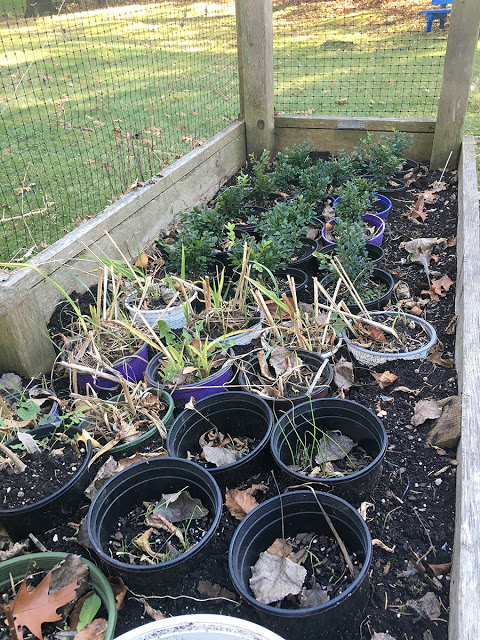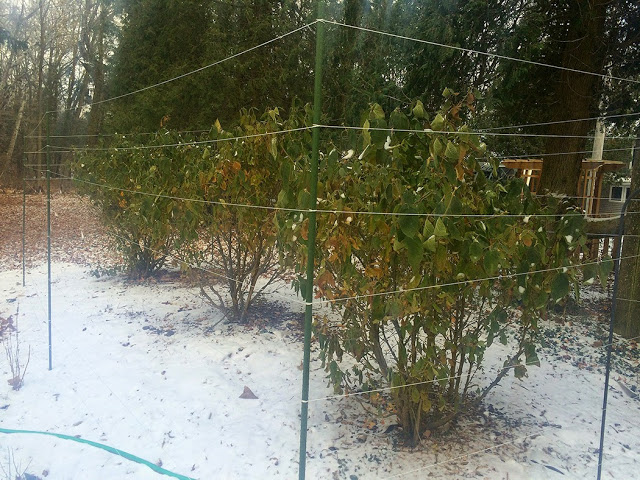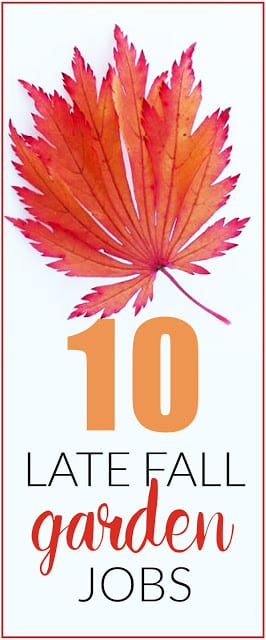As a Midwesterner, I have been raised to be excellent at complaining about the weather. It’s the No. 2 most popular hobby in these parts, bested only by something related to football. But this fall we’ve had absolutely nothing to complain about. This El Niño year has given us the most lovely weather, including the conditions we enjoyed this past weekend when I was able to garden in shorts for most of Sunday. On November 15. That is unheard of here.
Much of the country has been enjoying equally unseasonably warm weather, so even though we are all making holiday lists and dreaming of leftover turkey sandwiches and pumpkin pie, there are still garden chores we can do now. And anything you do now will only make your life easier come the busy spring gardening season.
 |
| I rake the leaves out of the bed and Mr. Much More Patient swings by in the lawn mower and mulches and collects them. |
1. Deal with the leaves.
Rake leaves out of garden beds and off of your lawn. I’ve been reading a lot of new theories on leaf management, many advocating leaving them where they lie for the benefit of wildlife, but I’m not a fan. I suppose that works if you don’t have a lot of leaves or if you live in the middle of a city where places for wildlife, but here, where the leaves fall a foot deep and there are more than enough places for wildlife to take refuge, the disadvantages of leaving leaves far outweigh the advantages. Leaves form thick, solid mats that foster mildew and lawn problems, and insulate garden beds, making them perfect for protecting nasty weeds. I’m not saying you have remove every last one, but get the majority out of the way. Plus, if you don’t pick up leaves you will miss out on the chance to turn them into leaf mold simply by doing nothing but putting them in bags or in a pile and letting them rot down, and thus creating an great soil amendment.
2. Clean your tools.
This is the last gardening project I’ll do this year, as I use my tools every time I’m in the garden. But at the end of the season, I’ll bring them all in the basement, give them all a good scrub, sharpen them if needed, oil the blades and apply a little boiled linseed oil to the wood handles. When spring comes they’ll be good to go.
3. Weed!
Weeding is no more fun in fall than it is in spring, but you’re going to have to do it sometime, so if you can stand it now, do it. Some perennial weeds like offender No. 1 around here—garlic mustard weed—are easy to pull and stand out bright green against the fading garden so it’s easy to spot them.
4. Put away pots.
Dump out pots and store them in a protected area for winter. Bonus points if you clean them first, but I’ve never bothered. At most I give them a rinse in spring before planting, but it really is better to scrub them out with a diluted bleach solution. (Do as I say, not as I do.)
 |
| A couple dozen pots of perennials are heeled in the raised vegetable garden for winter. When the ground freezes, I’ll throw on a layer of mulch for some extra protection. |
5. Heel in perennials still in pots.
Any plants that you haven’t had time to put in the ground have officially missed the planting window if you’re in zone 7 or lower. No worries: Just find an out-of-the-way spot in your garden, and bury the pots up to about an inch from the rim. Keep them well watered while you can and after the ground freezes, give them a nice layer of mulched leaves (I know, I told you to get rid of them, but mulched leaves are different), straw or evergreen boughs. I always use a corner of my raised garden for this and the pots are removed by the time I need to plant seeds.
6. Plant bulbs.
Yep, there’s still time; you can plant bulbs right up until the ground freezes. A bonus is that many stores and bulb companies are offering fantastic sales for procrastinators so you can really make out.
7. Keep everything watered.
I’m absolutely convinced that one of the critical factors in a plant surviving a tough winter is whether it enters winter well watered. As long as you can use your hose, keep watering. And yes, these last two tips are repeats from my September suggestions, but they still apply even two months later.
8. Cut back perennials. Selectively.
There’s a fair amount of research that suggests that perennials fare better when left to stand over winter, but it’s not always possible to leave an entire garden standing. Some plants just look terrible going into winter, have flopped completely or are prone to reseeding, which makes them good for birds but not great for the gardener. Other plants like hostas turn into a goopy mess that fosters and environment that’s perfect for nasty things like slugs to hide and lay eggs. I’d say I cut back about half the garden in fall and finish the rest in spring. I leave a few things standing because it makes the winter landscape much more attractive, but I like to get a jump start on spring gardening.
 |
| Last year I used string wrapped around stakes to protect plants from deer. This year I may try just using a deer repellent. |
9. Protect sensitive plants.
Anything that is questionably hardy, particularly beloved or dear or expensive and on its first year (so I don’t really know how hardy it is here), usually gets a layer of protection. For some plants, this is burlap, which can protect flower buds set in summer and fall. Many others get a chicken wire cage that will be stuffed with shredded leaves or evergreen boughs after the ground freezes. This protects them from wind and sun scald more than cold, which is often blamed for damage caused by the former conditions. Equally as important is protection from deer, who get very hungry when snow is covering everything else they eat. Last year I caged almost everything, but it was a lot of work and quite unattractive. This year I think I’m going to use deer repellant. I have been using Messina’s Deer Stopper II all summer and have been very impressed so I think I’m going to give it a real workout by trying it over winter as well. Reapplying it won’t be particularly fun but it will be a good excuse to trudge around the yard in the snow.
10. Bonus job: Edge beds.
I never seem to get to this in fall at home, but at one of the master gardener projects I work at, we always edge the garden bed in fall and it makes that job so much easier and faster in spring. It will also help keep grass from creeping in beds in spring before you can get out there to garden.



5 Responses
Fantastic advice. Winter (and late fall) aren't necessarily "do-nothing" times in the garden! Mel at catesgarden
You're sure much more organized than I am. I never get around to edging until spring — if then! 🙂 I do have most of the fall tasks that I absolutely Need to do finally done now, which is good, since cold weather is coming our way. Thanks for the reminders! -Beth
Despite doing lots, I still have most things on your list to do to at least some degree. Still leaves on a couple of trees and pots on the deck and by yhe front door. Could not bring myself to dump them yet.
Thanks for the tips, I've just moved into a place with a garden and I'm not entirely sure how to go about looking after it, so this has really helped!
great tips. I leave leaves where possible and remove where prudent. Surprise surprise I'm OCD about my tools being cleaned and oiled, though I won't do that this year because they're still immaculate from last year. Oops.